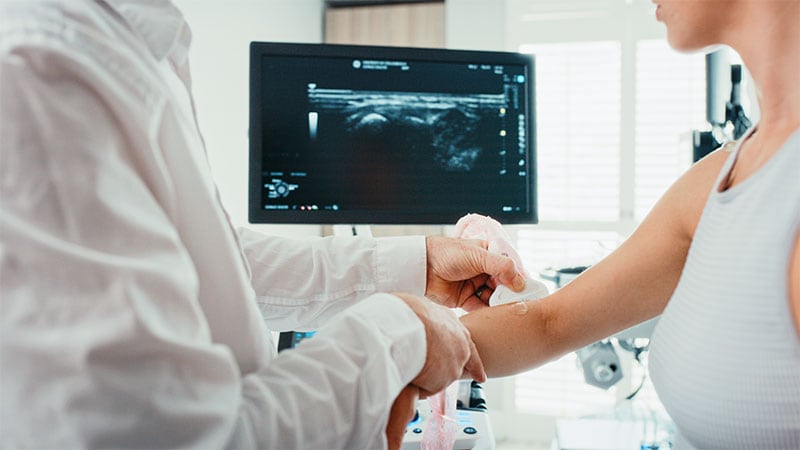TOPLINE:
In patients with mild psoriasis and no initial musculoskeletal signs, ultrasound bursitis at entheses was associated with the development of inflammatory symptoms suggestive of psoriatic arthritis (PsA), and those who developed musculoskeletal symptoms had higher BMI and fatigue scores and had a higher risk for transition to PsA.
METHODOLOGY:
- This prospective multicentre study included 78 patients with mild psoriasis without musculoskeletal symptoms who were not on systemic treatment; 82% of them had mild disease and 39.7% presented with onychopathy.
- Researchers performed ultrasound evaluation of 40 joints and 10 entheses bilaterally at baseline and during follow-up; these were assessed for synovial hypertrophy, power Doppler signal, and entheseal changes including bursitis.
- Study outcomes were the diagnosis of PsA and new-onset musculoskeletal symptoms. The median follow-up duration was 76.6 months.
TAKEAWAY:
- Among 60 patients who completed the study, 6.6% developed PsA over a mean of 20.2 months according to the CASPAR criteria, corresponding to the annual incidence of approximately 1%.
- Overall, 56.6% of patients developed musculoskeletal symptoms and had significantly higher BMI (P = .013) and abdominal circumference (P = .022) at baseline.
- These patients also scored higher on pain (2.14 vs 0.91; P = .047) and fatigue (3.25 vs 1.21; P = .011) components of the baseline Psoriatic Arthritis Impact of Disease questionnaire than those not developed musculoskeletal symptoms.
- Ultrasound bursitis at entheses was present in 80% of patients who developed inflammatory arthralgia suggestive of PsA (P = .049).
- The total joint ultrasound score at baseline was significantly higher in patients who developed musculoskeletal symptoms (P = .037).
IN PRACTICE:
“Around half of the patients with PsO [psoriasis] developed MSK [musculoskeletal] symptoms during the follow-up and they had significantly higher BMI, more joint US [ultrasound] findings and scored higher in pain and fatigue scales at baseline PsAID [Psoriatic Arthritis Impact of Disease] questionnaire, defining a subgroup with potentially higher risk to develop PsA. On the other hand, US bursitis at enthesis was related to the onset of MSK symptoms suggestive of PsA,” the authors wrote.
SOURCE:
This study was led by Ana Belén Azuaga, Hospital Clinic, Barcelona, Spain. It was published online on June 04, 2025, in Rheumatology.
LIMITATIONS:
The sample size was relatively small, potentially underestimating the incidence of PsA in patients with psoriasis. The exclusion of patients with musculoskeletal symptoms and those on systemic therapy likely excluded individuals with a higher risk of developing PsA. Additionally, a significant proportion of patients initiated disease-modifying antirheumatic drug therapy during the study, including biologics, which could have affected the development of PsA symptoms.
DISCLOSURES:
This study was supported by research grants from Pfizer and Novartis. Additional support came from the Innovative Medicines Initiative 2 Joint Undertaking. The authors declared having no conflicts of interest.
This article was created using several editorial tools, including AI, as part of the process. Human editors reviewed this content before publication.
Source link : https://www.medscape.com/viewarticle/ultrasound-bursitis-and-higher-bmi-predict-musculoskeletal-2025a1000fij?src=rss
Author :
Publish date : 2025-06-12 12:00:00
Copyright for syndicated content belongs to the linked Source.
